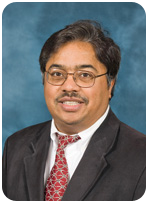即可将网页分享至朋友圈
由电子科学与工程学院主办的“电子论坛”第59期邀请到美国密歇根大学电气工程与计算机科学学院教授Pinaki Mazumder,与我校师生共同探讨集成电路与半导体器件的发展。具体安排如下,欢迎感兴趣的师生参加。
主 题:VLSI Systems in Beyond Moore’s Law Era
主讲人:Prof. Pinaki Mazumder (professor of electrical engineering and computer science at the University of Michigan)
时 间:2019年3月4日(周一)10:30-12:00
地 点:沙河校区逸夫楼512
内容简介:
It is a fait accompli that the end of shrinking era for VLSI chips that was fueled by Moore’s Law is looming over the horizon as CMOS technology is approaching its limits with respect to chip integration density, speed, and power consumption. Over the past twenty years, my research group has developed innovative circuits and CAD tools for the Beyond Moore’s Law technologies that rely on (i) quantum tunneling in transistors, nanowires, and quantum boxes; (ii) ionic transport through complex metal oxide films; (iii) strain-assisted spin-polarized electron tunneling through paramagnetic material, and (iv) spoof surface plasmon polariton (SSPP) mode slow electromagnetic wave propagation through specially-engineered structures. These emerging technologies augur a revolutionary shift of design paradigms for integrated circuits and CAD tools that must account for quantum effects in nanoscale devices as well as local interactions between circuit elements in unconventional architectures. In this talk, I shall mainly address two different areas of research that my group has been doing for the past 25 years: (i) Quantum Electron Devices and Architectures with supporting quantum physics based modeling, simulation and optimization tools. (ii) Emerging Terahertz Technology for information processing, biosensing and quantum communications. Absence of THz transistors with significant gain has pushed us to develop metamaterial engineering to mimic surface plasmon polariton mode of slow electromagnetic THz surface wave propagation for constructing innovative components such as THz switches, THz interconnect, THz Analog-to-Digital Converter (ADC), Beam Splitter for THz QKD, and so on. The talk will briefly describe the theory and applications of THz technology that is poised to push the traditional boundaries of THz from time-domain spectroscopy (TDS), imaging, remote sensing, and biosensing to the new era of classical and quantum information processing and communications.
主讲人简介:

Pinaki Mazumder: Professor received his PhD in Electrical and Computer Engineering from the University of Illinois at Urbana-Champaign in 1988 after he received his MS degree in Computer Science from University of Alberta in Canada, BS degree in Electrical Engineering from Indian Institute of Science at Bangalore, and BSc Physics Honors degree from Guwahati University in India. He is a professor of electrical engineering and computer science at the University of Michigan where he has been teaching for the past 31 years. He spent 3 years at National Science Foundation serving as the lead program manager of Emerging Models and Technologies (EMT) program in the CISE Directorate as well as leading the quantum, molecular and high-performance simulation (QMHPS) program in the Engineering Directorate. He worked for 6 years at AT&T Bell Laboratories in USA and BEL in India, and spent his sabbatical year at Stanford University, University of California at Berkeley, and NTT Center Research Laboratory in Japan. He has published over 340 technical papers and 6 books on various aspects of VLSI systems. In evolutionary CMOS research, Prof. Mazumder solved numerous use-inspired research problems that were at least ten years ahead of their time and eventually Moore’s Law has vindicated the practical merits of his research in CMOS technology. To wit: his research in testable DRAM circuits, in-line accelerated testing procedures for high-density RAM chips, and testing of embedded ROM and SRAM through JEDEC boundary scan ports are widely used in commercial chips by semiconductor random-access memory and FPGA manufacturers. In revolutionary emerging technologies, Professor Mazumder has made sustained impact for the past 20 years in CAD tools and circuit designs for emerging technologies including quantum MOS, spintronics, spoof plasmonics, and resonant tunneling devices. Prof. Mazumder is an AAAS Fellow (2007) and an IEEE Fellow (1999) for his distinguished contributions to the field of VLSI.
电子科学与工程学院
2019年3月1日
编辑:卫道鸿 / 审核:王晓刚 / 发布:陈伟


